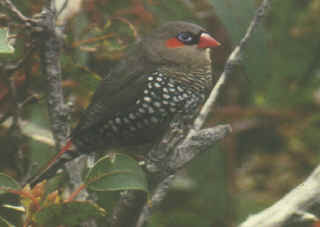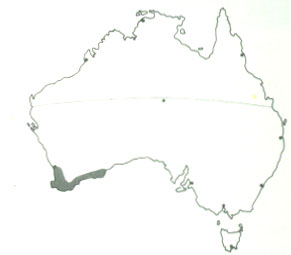![]()
 |
 |
DISTRIBUTION: Uncommon, in dense heath and uncleared gullies in south-western Australia. |
Red-eared Firetail. |
Distribution Map |
|
IDENTIFICATION. LENGTH = 120 mm MALE: Head, back and wings olive-brown finely barred with black; rump, upper tail-coverts and outer edge of tail crimson; central tail-feathers barred with olive-brown. Lores and forehead black; crimson patch behind eye; this becomes darker when breeding. Breast buff-brown finely barred with black; lower breast, belly and undertail-coverts spotted black and white. Eye red with pale blue naked eye ring; bill scarlet; legs dark brown. FEMALE: Similar to male in non-breeding plumage. IMMATURES: Like adults but no crimson ear-patch or spots on belly; bill black.
|
NESTING. Breed September-January. Nest a horizontal, bottle-shaped structure with a spherical entrance chamber and long, narrow entrance tunnel, 350-400 mm long, 160 mm high and 150-200 mm wide. Outer walls strongly built of twining green stems; inner walls of softer shorter stems lined with feathers; placed 7-15 m high in trees and shrubs. Eggs: four to six; pure white; 18 X 12 mm.
|
|
FORMS.
|
|
AVIARY BREEDING. NESTING TYPES: I have found that these birds will nest almost anywhere although they will usually prefer a nest box including parrot nest boxes rather than build a nest of their own. I have seen these birds build nests in tea tree branches and planted trees but very rarely. Best results have been from boxes 150 mm square X 125 mm high with a 40 mm access hole in the front and a small landing platform just below the entrance. (See the Plans page for more information) FEEDING: A general finch mix is ideal for this bird. Birds will also readily take seeding grasses and live food. However I have had seen these birds breed successfully with just a mixed seed diet. Egg and biscuit will also be taken readily. OTHER FEEDS: Cuttlebone and shell grit should be supplied at all times. SPECIAL REQUIREMENTS: There are no special requirements for this species. However care should be taken not to house this species with the Masked Finch or the Long-tailed Finch or any of the subspecies.
|
| AVIARY SPECIFICATIONS. | WIRE MESH: 1/4 x 1/4 or 6 mm x 6 mm | Also known as mouse wire |
| LENGTH: 11ft 6in or 3575 mm | WIDTH:6ft or 1800 mm | HEIGHT: 8ft or 2400 mm |
| SHED: Half the aviary should be enclosed.
These are recommendations only and individual breeders may have different dimensions and specifications.
|
FLOOR: I have found a dirt floor preferable. |
OTHER: |
|
BREEDER SUBMISSIONS. |
|
| From |
![]()
Author
P Campbell
Copyright © 2002 P. Campbell. All rights reserved.
Revised: April 23, 2002
.